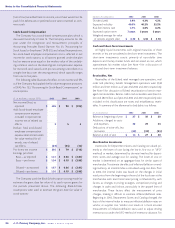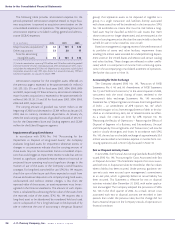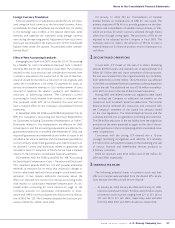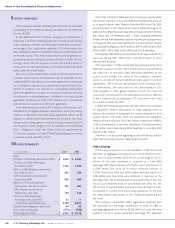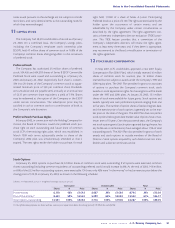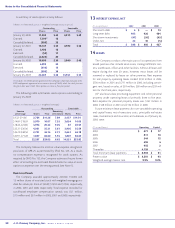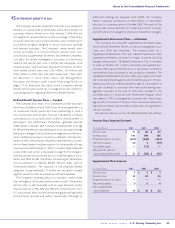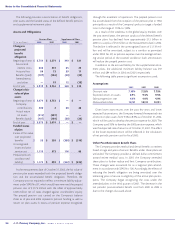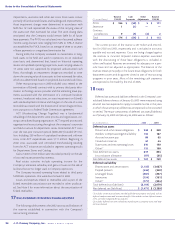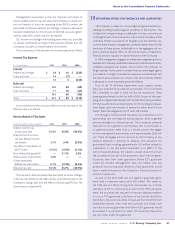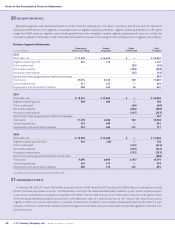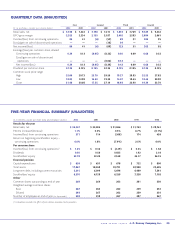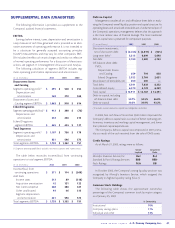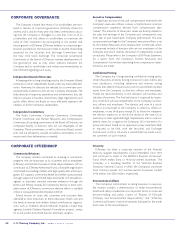JCPenney 2002 Annual Report Download - page 37
Download and view the complete annual report
Please find page 37 of the 2002 JCPenney annual report below. You can navigate through the pages in the report by either clicking on the pages listed below, or by using the keyword search tool below to find specific information within the annual report.
J. C. Penney Company, Inc. 2002 annual report34
Notes to the Consolidated Financial Statements
The following provides a reconciliation of benefit obligations,
plan assets and the funded status of the defined benefit pension
and supplemental retirement plans:
Assets and Obligations
Pension Plans Supplemental Plans
($ in millions) 2002 2001 2002 2001
Change in
projected
benefit
obligation
Beginning of year $ 2,754 $ 2,574 $ 310 $ 321
Service and
interest costs 264 272 25 25
Actuarial loss 88 73 39 11
Benefits (paid) (187) (184) (28) (28)
Amendments
and other —19 12 (19)
End of year $ 2,919 $ 2,754 $ 358 $ 310
Change in fair
value of plan
assets
Beginning of year $ 3,074 $ 3,753 $—$—
Company
contributions 300 228 28
Actual return
on assets (215) (497) ——
Benefits (paid) (187) (184) (28) (28)
End of year $ 2,972 $ 3,074 $—$—
Funded status
of plan
Excess of fair value
over projected
benefits $53$ 320 $ (358) $ (310)
Unrecognized
losses and prior
service cost 1,119 572 116 85
Prepaid pension
cost/(accrued
liability) $ 1,172 $ 892 $ (242) $ (225)
At the measurement date of October 31, 2002, the fair value of
pension plan assets exceeded both the projected benefit obliga-
tion and the accumulated benefit obligation. Therefore, the
Company was not required to reflect a minimum liability adjust-
ment under SFAS No. 87, which would have removed the prepaid
pension cost of $1,172 million with the offset of approximately
$700 million net of taxes charged against stockholders’ equity.
The prepaid pension cost carried on the Company’s balance
sheet as of year-end 2002 represents pension funding as well as
return on plan assets in excess of pension expense recognized
through the statement of operations. The prepaid pension cost
has accumulated from the inception of the pension plan in 1966
principally as a result of the Company’s policy to target a funded
ratio in the range of 110% to 130%.
As a result of the weakness in the global equity markets over
the past several years, the pension surplus of the defined benefit
pension plans has declined from approximately $1.2 billion in
2000 to a surplus of $53 million at the measurement date in 2002.
The decline is reflected in the unrecognized losses of $1,119 mil-
lion and will be amortized, subject to a corridor as permitted
under SFAS No. 87, as pension expense over the average remain-
ing service period of the covered workforce. Such amortization
will reduce the prepaid pension cost.
In addition to the accrued liability for the supplemental retire-
ment plans, the additional minimum liability balance was $97
million and $84 million in 2002 and 2001, respectively.
The following table presents significant assumptions used:
Assumptions
2002 2001 2000
Discount rate 7.10% 7.25% 7.75%
Expected return on assets 8.9% 9.5% 9.5%
Salary progression rate 4.0% 4.0% 4.0%
Measurement date 10/31 10/31 10/31
Given lower asset returns over the past few years and lower
expected future returns, the Company lowered the expected rate
of return on plan assets from 9.5% to 8.9% as of October 31, 2002,
which will be used to develop the pension expense for 2003. The
Company used 9.5% to develop the 2002 pension expense, which
was the expected rate of return as of October 31, 2001. The effect
of the lower expected return will be reflected in the calculation
of net periodic pension cost for fiscal 2003.
Other Post-Retirement Benefit Plans
The Company provides medical and dental benefits to retirees
based on age and years of service. Benefits under these plans are
unfunded. The Company provides a defined dollar commitment
toward retiree medical costs. In 2001, the Company amended
these plans to further reduce and limit Company contributions.
These changes were accounted for as a negative plan amend-
ment in accordance with SFAS No. 106. Accordingly, the effects of
reducing the benefit obligation are being amortized over the
remaining years of service to eligibility of the active plan partici-
pants. The Company began recognizing the costs under the
amended plans in the third quarter of 2001. The decrease in the
net periodic post-retirement benefit cost from 2000 to 2002 is
due to the changes discussed above.


